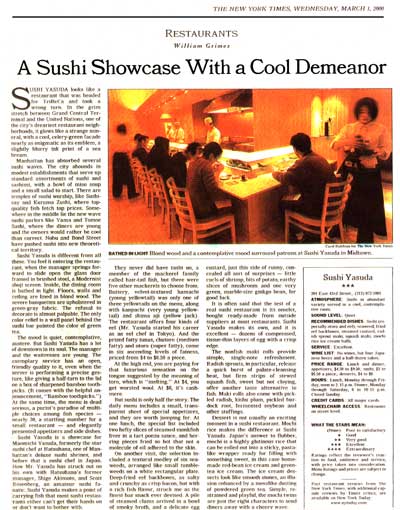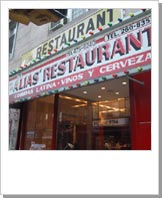| • | • | • | • | • | • |
|
|||||||
 Two Times a Chef If you're an enterprising young chef, it must be tough running only one kitchen these days -- friends and colleagues might think you're a slacker. With the February 1 opening of his Alias Restaurant, a more ambitious sibling to the terrific AKA Cafe (both offshoots of 71 Clinton Fresh Food), Scott Ehrlich (pictured) joins the ranks of chef-nomads like Mario Batali and Tom Colicchio, wandering tocques who hustle from one hot spot to another on a nightly basis. Since Alias (formerly a Latino rice and beanery also called Alias) is only half a block south of AKA, Ehrlich doesn't have far to go -- a good thing if you wear clogs to the office. There, in a dining room designed by Takehiro Murao, the architect responsible for Jewel Bako, and a kitchen twice the size of AKA's, he'll have more room to experiment with clever pan-American bistro dishes like fried rabbit and waffles, skate fish cakes, and, in tribute to a fading Lower East Side industry, a pickle-plate appetizer. Alias 76 Clinton Street |
|||||||
 |
THE NEW YOKK TIMES. WEDNESDAY, MARCH , 2000 | ||||||
RESTAURANTS William Grimes A Sushi Showcase With a Cool Demeanor |
|||||||
| SUSHI YASUDA looks like a restaurant that was headed for Tribeca and took a wrong turn. In the grim stretch between Grand Central Terminal and the United Nations, one of the city's dreariest restaurant neighborhoods it glows like a strange mineral with a cool. celery-green facade nearly as enigmatic as its emblem, is slightly blurry ink print of a sea beam, Manhattan has absorbed several sushi waves. The city abounds in modest establishments that serve up standard assortments of sushi and sashimi with a bowl of miso soup and a small salad to start There are temples of sushi worship, like Sushi" say and Konima Zushi, where top-quality fish fetch top prices. Somewhere in the middle lie the new wave sushi parlors like Yama and Tomoe Susht, where the diners are young and the owners would rather be corf than correct. Nobu and Bond Street have pushed sushi into new theoretical territory.
Sushi Yasuda is different from all these. You feel it entering the restaurant, when the manager springs forward to slide open the glass door framed in hi ushed steely a Modernist shoji screen. Inside, the dining room is bathed in light. Floors, walls and ceiling are fined in blond wood.Thesevere hanqi»ettes are Upholstered in green-gray fabric. The refusal to decorate is almost palpable. The only color relief is a wall panel behind the sushi bar painted the color of green tea* The mood is quiet, contemplative, austere. But Sushi Yasuda has a lot of downtown in its soul. The manager and the waitresses are young. The exemplary service has an open, friendly quality to it, even when the server is performing a precise gesture. like giving a half-turn to the lid on a box of sharpened bamboo toothpicks, lt comes with the helpful announcement, "Bamboo toothpicks." At the same time. the menu is dead serious, a purist's paradise of multiple choices among fish species nearly 30, a startling number for a small restaurant — and elegantly presented appetizers and side dishes- Sushi Yasuda is a showcase for Maormch* Yasuda, formerly the star sushi chef at Hatsuhana, |

|
||||||

Scientists claim that winter makes people depressed. Less light = sad days. How do we cure our winter blues? Comfort food. Wait,
If the food's not enough to lift your mood, the cheery interior should do the trick. Designed by Takehiro Murao of Jewel Bako, the small restaurant is draped in warm oranges and reds. Cutest feature? The old-school bodega-style sign on the storefront. If all else fails (you've got it bad!), hit one of the new bars in the 'hood on the way home. But remember, sunshine, spring is just a few weeks away. Alias Restaurant, 76 Clinton Street, at Rivington Street (212-505-5011). |
|||||||

